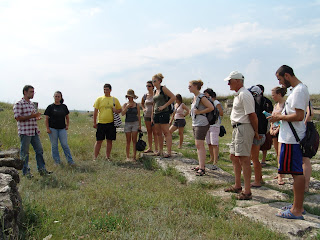Nicole Aszalos:
“On the first day of excavations I found a really nice curved piece of pottery and when I washed it that weekend, there was a nice red leaf decoration on it. Then just last Friday I dug up those bones which were pretty exciting. But the best part of the trip was meeting everyone here and becoming friends with them and experiencing the culture (and the food). I will definitely miss here when it’s over.”
Carolyn Clarke:
“On August 25, 2011 in the morning I found a small shard of an Archaic piece of pottery. The piece came from the bottom of the pit dug in the center of Tomb 3. It is easily identifiable because of the black lines on it that would have spiraled around the neck of the piece, the rest is painted red which is rather rare according to Dr. Schaus. He also says that it is easily the oldest fragment found in the Necropolis thus far.”
Shelby Haggerty:
“My name is Shelby Haggerty and I'm an undergraduate atWilfrid Laurier University in Canada
Shelby Haggerty:
“My name is Shelby Haggerty and I'm an undergraduate at
Frances Jardine:
Thomas Krol:
Anna Laytner:
Our excavating manner has improved noticeably since the first day we started excavating at the site. We use to focus on removing the dirt and material quickly to reveal the features and tombs. Now that all the tombs we are going to work on this season are revealed, we are focusing more on the smaller material finds that we previously left in situ. The students are more experienced now and are using the skills they've acquired over the past few weeks to carefully reveal and remove burial goods.
I have been excavated in Tomb 7 and working on revealing a large broken amphora. The vessel is located right over the pyre and we are finding a lot of burned areas. In this day alone I found more material than in any of the other days working at Orgame. It has been a very exciting and productive day!”
Sarah Timmins:

































